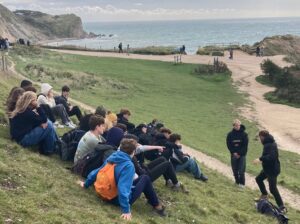From Friday, 27th September, to Sunday, 29th September 2024, 60 Year 11 students swapped their classroom desks for the great outdoors, embarking on a three-day Geography fieldwork trip to Dorset. It was an action-packed weekend, blending human and physical geography, with the students exploring two of Dorset’s most iconic landscapes: Poundbury and the Jurassic Coast.
Friday: Investigating the Sustainability of Poundbury
The trip kicked off on Friday with a visit to Poundbury, a unique town founded by King Charles III. Known for its ambitious urban design and sustainability goals, Poundbury is a model for how future towns might look and operate. The students were tasked with investigating the town’s sustainable features, from its energy-efficient buildings to its green transport systems. The project challenged them to think about whether Poundbury truly lives up to its reputation as an eco-friendly community.
The day started with heavy rain as the group departed from Emanuel School, setting a challenging tone for the journey ahead. However, by the time they arrived in Poundbury, the rain had eased off just long enough to allow for two solid hours of uninterrupted fieldwork. Armed with clipboards and raincoats, the students observed the town’s layout, and analysed how well the town is designed to meet modern environmental standards.
Saturday: Coastal Management in Swanage Bay and a Challenging Hike
Saturday dawned bright and sunny, perfect for the students’ coastal management fieldwork in Swanage Bay. After the previous day’s rain, the clear skies were a welcome change. The focus for the day was coastal management—specifically, how groynes and beach replenishment help to protect the coastline from erosion.
The students spent the morning measuring groynes, analysing their effectiveness, and using tape measures and ranging poles to record beach profiles. This hands-on work gave them a real insight into how human intervention is used to protect natural landscapes, making their studies come alive in a way that only fieldwork can.
But the day didn’t end there. After the morning’s fieldwork, the students embarked on a challenging hike to Studland Bay, visiting the famous stack of Old Harry along the way. The route took them along cliff paths and offered stunning coastal views, though it was not without its difficulties. The hike was long and tested their stamina, but it was fun and a chance to experience Dorset’s rugged beauty up close.
Sunday: Exploring Durdle Door and Lulworth Cove
The final day of the trip took the group to Durdle Door and Lulworth Cove, two of the most breathtaking natural landmarks on the Jurassic Coast. This was a day of exploring geomorphology—understanding the dramatic rock formations and how the coastline has been shaped over thousands of years.
Unlike Saturday’s calm conditions, Sunday brought some wind, making it a little more challenging to explore. However, the students were undeterred. They took in the stunning limestone arch of Durdle Door and marvelled at the unique features of Lulworth Cove, learning about the geological processes that created these incredible sites. As the wind whipped through the landscape, it was a real reminder of the power of nature and the dynamic processes that shape our coastlines.
A Weekend of Learning Outside the Classroom
Despite the mixed weather—ranging from heavy rain to brilliant sunshine—Year 11 students made the most of this Geography fieldwork weekend. Whether braving the rain in Poundbury, enjoying the sunny coast at Swanage, or tackling the winds at Durdle Door, the trip was a mix of fun, learning, and adventure. It gave them the opportunity to see real-world applications of their classroom lessons, and no doubt, it will be an experience they’ll remember for years to come.
Mr Worrell, Geography Teacher














